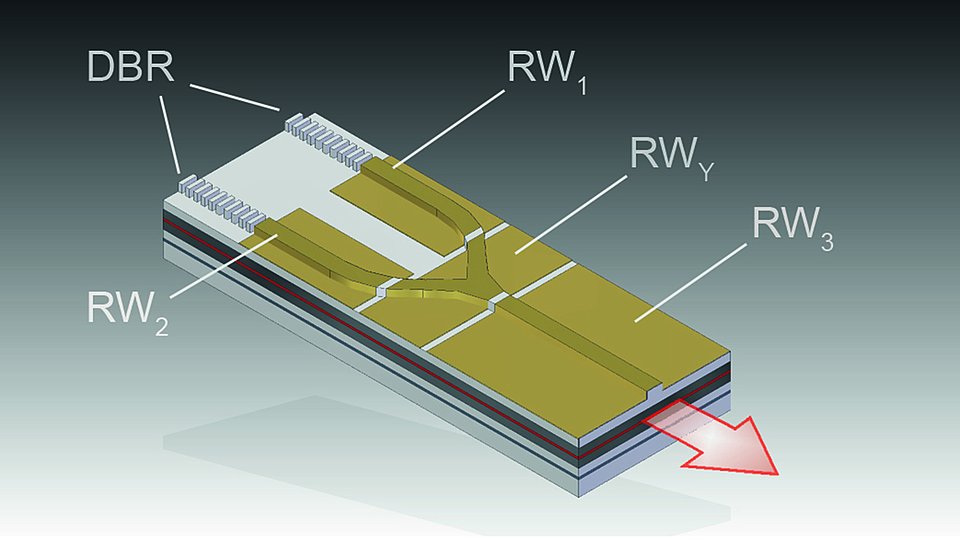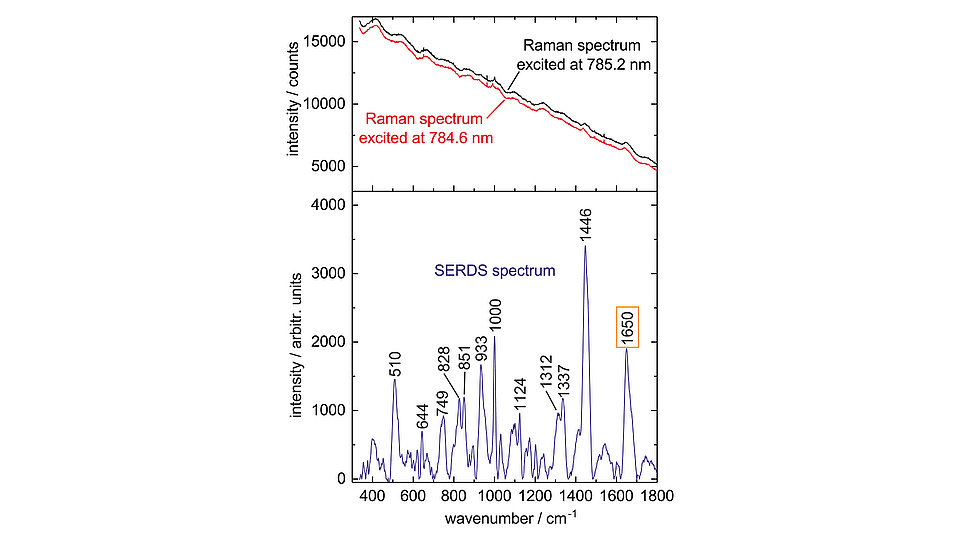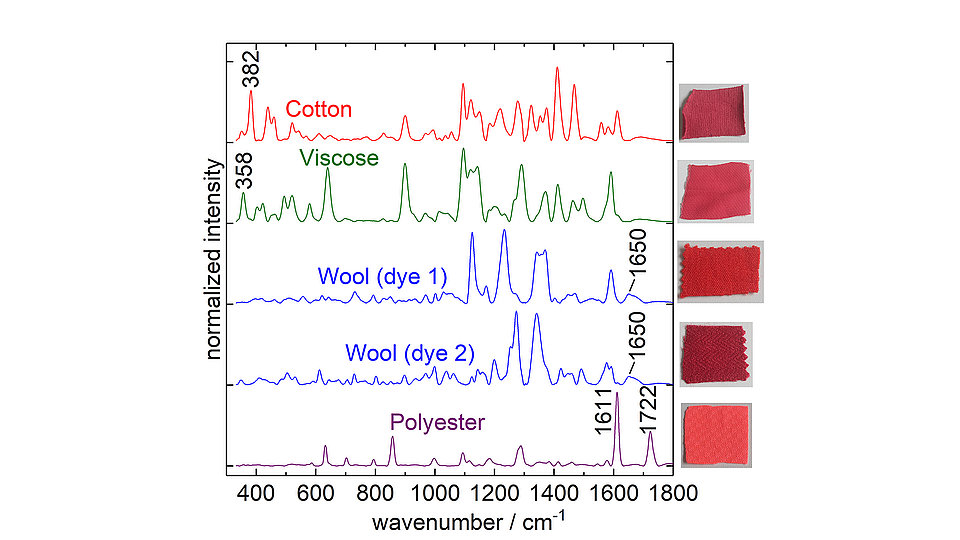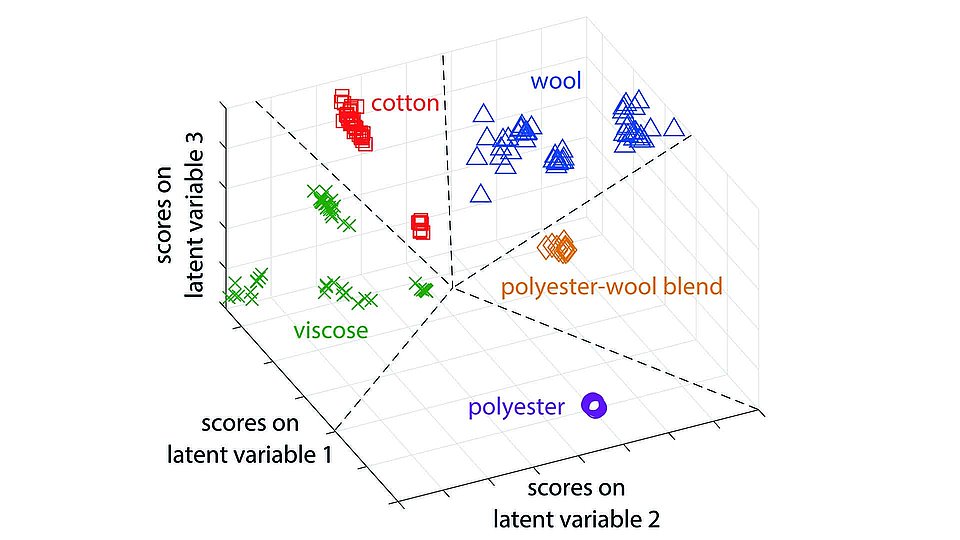Textile material identification using Shifted Excitation Raman Difference Spectroscopy
Fig. 1: Raman spectra of an undyed wool sample excited at two slightly shifted laser wavelengths (top) and reconstructed SERDS spectrum, numbers identify Raman signals of proteins, material-specific Raman signal for identification of wool is highlighted by rectangle (bottom).
Fig. 2: SERDS spectra of red textiles composed of different materials, spectra are normalized and vertically offset for clarity, numbers indicate material-specific Raman signals. Images on the right show photographs of corresponding textile samples.
Textiles, such as clothing and furniture, are an integral part of our everyday lives. Understanding about how they are composed is relevant during production, for recycling, and forensics. Today, more than ever before, the demand on the textile industry is focused on sustainable recycling aiming towards a circular economy. Identifying textile materials, especially the colored ones, is an important requirement to choose material-specific recycling pathways, yet remains unsolved.
A potential solution offers Raman spectroscopy, applied for rapid and non-destructive analysis of dyed textiles in various colors. By providing a molecular fingerprint of the textile sample, it gives insights into its chemical composition. To address fluorescence interference caused by the fiber material or added dyes, we use Shifted Excitation Raman Difference Spectroscopy (SERDS). This technique applies two slightly shifted narrow-band laser excitation wavelengths. Raman signals follow the shift in wavelength while fluorescence remains unaffected. We conducted SERDS pilot investigations to identify 22 dyed and undyed textiles produced from cotton, viscose, wool, and polyester as commercially relevant materials. Experiments are performed using a compact laboratory setup, applying an in-house developed dual-wavelength diode laser emitting at 784.6 nm and 785.2 nm as excitation light source.
Fluorescence interference which masks characteristic Raman signals is observed even for undyed textiles, as exemplarily shown for wool in Fig. 1. However, SERDS enables to efficiently separate the Raman spectroscopic fingerprint of the sample from interfering contributions like fluorescence. With this technique, Raman signals of proteins can be detected, which allows to identify the textile material unambiguously as wool.
For dyed samples, we have to deal with Raman signals originating from the material but also signals attributable to the dye. This is exemplarily illustrated in Fig. 2 for SERDS spectra recorded from red textiles made of cotton, viscose, wool, and polyester. Despite strong contributions from Raman signals originating from the dyes, material-specific Raman signals are significant to identify the textiles as cotton (382 cm-1), viscose (358 cm-1), wool (1650 cm-1), and polyester (1611 cm-1 and 1722 cm-1). For the two red wool samples, the SERDS spectra additionally confirm that different dyes have been used as evidenced by distinct Raman spectral patterns obtained.
Regarding automated textile sorting, we used partial least squares discriminant analysis (PLS-DA) on the SERDS spectra. PLS-DA results show an excellent material-specific classification performance, achieving 100 % accuracy. Illustrated in Fig. 3, distinct clusters representing various material groups highlight the capability to reliably identify textiles made of single materials as well as binary material blends, regardless of color.
Our study, performed in cooperation with Technische Universität Berlin, demonstrates that SERDS is capable of identifying and discriminating selected textiles produced from commercially relevant materials. The investigations form a solid basis for textile analysis using SERDS in application areas like the textile industry and forensics.
The study was funded by the Federal Ministry of Education and Research (BMBF) within the iCampµs project, grant numbers 16ES1132 and 16ME0425, and by the German Federal Ministry for the Environment, Nature Conservation and Nuclear Safety (BMUV), grant number 67KI2016.
Publications
K. Sowoidnich, K. Rudisch, M. Maiwald, B. Sumpf, K. Pufahl, "Effective Separation of Raman Signals from Fluorescence Interference in Undyed and Dyed Textiles Using Shifted Excitation Raman Difference Spectroscopy (SERDS)," Appl. Spectrosc. Pract., vol. 1, no. 2, pp. 1–12, doi:10.1177/27551857231210893 (2023).
K. Sowoidnich, K. Rudisch, M. Maiwald, B. Sumpf, K. Pufahl, "Shifted Excitation Raman Difference Spectroscopy (SERDS) as a Promising Tool for Textile Material Identification," in Optica Sensing Congress 2023 (AIS, FTS, HISE, Sensors, ES), Technical Digest Series (Optica Publishing Group), paper AM2A.4 (2023).



